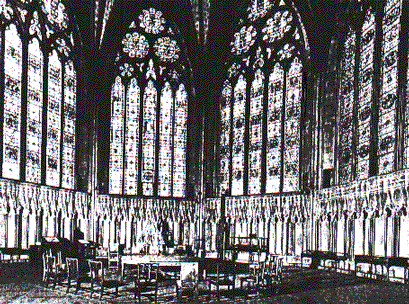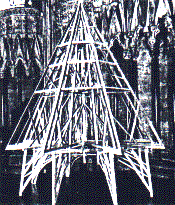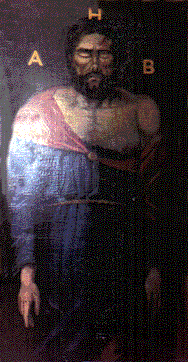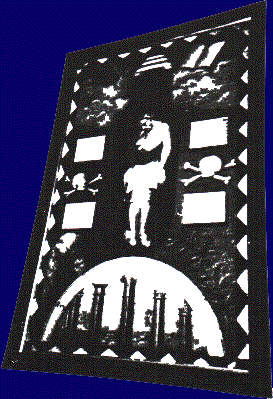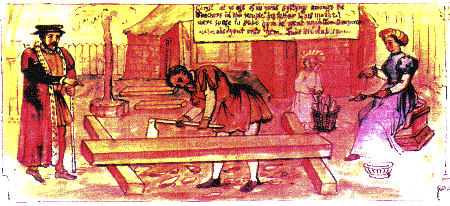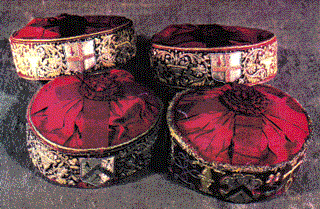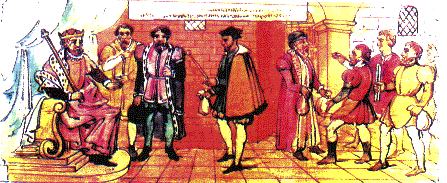|
CRAFT AND ROYAL ARCH LEGENDS
by
V. Wor. Bro. the Revd Neville Barker Cryer, M.A. P.G.C.
The main thesis of this paper is easily stated. The contention is that in
seeking to solve some of the long-standing questions relating to our Craft and
Royal Arch legends we have been too limited in looking for answers by
considering only material relating to the stone building trade. When we accept
the fact that Carpenters and joiners, as well as other trades, were also
considered 'Masons true' we begin to uncover possible new solutions. The main
secret is solved when we realise why we were originally thought of as 'Noachidae'
or 'children of Noah'.
Yet if the thesis is simple to state, its unravelling and proof may not be so
easy to present. This is because we need to overcome four hurdles:
- We need a redefinition of terms, e.g. 'Master 'or 'Mason', that have
acquired an identity that seems to be almost 'set in stone';
- We have to reconsider some existing views that might be regarded as
already beyond debate; e.g. Pre-1717 traditions are irrelevant;
- We shall have to admit some new facts, such as Tudor wall-paintings, that
may seem, at first, interesting but inappropriate or unnecessary;
- We have therefore to unpick a skein of ravelled threads that would seem to
defy the efforts of even the most patient student.
In the face of such a series of obstacles it would seem that the best course
to adopt is to surrender at once and concede defeat. Whilst the obvious choice
for any unwelcome intruder is to let sleeping dogs lie there are times when the
prize sought by the intruder is so worthwhile that all caution has to be thrown
to the winds and the danger from the dogs - or is it in this case the critics? -
has to be endured. This, I believe, is one of those occasions. It is time, once
more to engage with six questions that have battered at the doors of any
self-respecting English Masonic historian. What we seek is the solution to these
issues:
- What does the Graham Ms. contribute to our English Freemasonry?
- What is the likely basis of the 30 Hiram legend?
- What did Dr. Anderson intend by calling Masons Noachidae?
- What is the real place and point of the Ark Mariner degree?
- Where does the emphasis on Babylon come from?
- Where did the Josiah legend originate and where does it fit?
In what follows I adopt a line of argument; based on evidence, that seeks not
only to answer these questions satisfactorily but even shows that they are all
interrelated. To start this argument I begin with a vivid personal experience of
an aspect of architectural history.
In the summer of 1997 I took part in what have been a
regular series of lectures and activities organised by the Chancellor of York
Minster. Their purpose was to reveal to the public some of the history and
features that belong to that: church's long-standing fabric. The item which
specially caught my imagination: was a conducted visit to the Minster's Chapter
House, including what is known as the Masons's Chamber and above it the timber
scaffolding that supports the roof of this ancient meeting place. (fig. no.1)
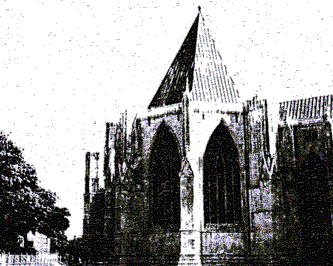
| fig. 1 The Chapter House itself
deserves a special study. It was first completed about 1260. This is
one of the most remarkable pieces of early medieval carpentry in
Britain and is still standing intact. There is a model of the roof
structure, the work of R. Littlewood, inside the Chapter House, fig.
3. |
|
As you visit these locations you acquire one abiding impression - the
intimate connection of the carpenters' skills with those of the stonemasons. The
Masons's Chamber was the room in which the designs for the constituent items of
stonework were drawn on the floor by the Master Architect and the outlines of
some of them are still extant. Hanging from the roof beams are the rows upon
rows of wooden templates which guided the stone carvers in the task of thus
fashioning the stones for vaulting ribs and window embrasures, for stall
canopies and the pedestals or heading of pillars, for ridges and gables - and it
is "relevant here to point out that a term then used for a gable-end was a
'chevron'. All these items of the stonemason craft thus depended for their
correct completion; on the no less skilful designs for those wooden outlines
executed by the carpenters on the Master Architect's instructions. You can
imagine the room being a hive of activity.
You then again mount the winding stairs and, on reaching the summit of the
stairway, step into an octagonal area. Soaring up above your head is an array of
massive beams, each great timber shaped and gently tapered to meet its
companions in the pointed space that marks the pinnacle of the Chapter House
roof whilst on the equally well chamfered and pegged cross beams there
are laid the waterproofing lead sheets above which the tiles create the outer
shell. (fig. nos. 2 & 3) Here, in one of the
most complex and impressive displays of carpentry and joinery in the whole of
Europe, you see the very skeleton and foundation that enables the stonework
beneath to remain dry, stable and secure. Nor is that all. From the very apex of
the roof there descends a central wooden pillar, like the main mast of an
old-time sailing ship, and as thick, but composed of three lengths of timber
since one alone could not take the strain. This great bastion of wood plunges to
the very base and foundations of the whole building, giving it immense poise and
anchorage. You realise, as you may never have realized before, that here is the
inner reality of this medieval erection - an inseparable union of at least two
great trades so as to produce this marvel of the York Chapter House. The masons
and carpenters are seen to have been working hand in hand.
| fig. 2 The Chapter House inside. fig. 3 The
model shows the timber structure above the ceiling. |
It is because we have so often overlooked or forgotten this partnership in
the operative period of our Carfts that it may come as something of a shock to
be reminded that our forebears did not make that mistake. A Dublin Memorandum of
1597 records "That we, the company of carpinders, maysons, joiners and millers
hath consulted and agreed amongst ourselves" OR to certify a wall's height at
the Tower of London it was done in the presence of William de Ramsey, chief
mason and William de Hurley, chief carpenter. In the History of the
Carpenters Company of London by Jasper Ridley (1995) one notes how many
times in the 15th and 16th centuries the masons and the
carpenters were summoned or charged by the Mayor and Corporation to act
together. (see e.g. pp.23, 32, 35 and fig. no. 4).
|
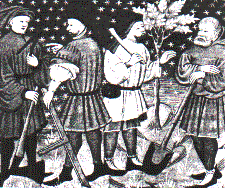
|
fig. 4. Craftsmen: carpenter,
gardener, forester, and various trades. French mid-15th century. |
|
That this was the case despite the fact that the Masons and the Carpenters
had their separate Charters, Guild halls and forms of livery is singular and
significant. What is no less striking is the clear similarity in the forms of
their heraldic arms: the Carpenters having three dividers or compasses around an
engrailed 'chevron' (fig. no. 5), whilst the Masons had three castles or towers
around a similarly engrailed chevron on which a pair of compasses is displayed
(fig. no. 6). What is even more singular is that on an eairlier form of
the Carpenter's arms we see the central chevron bearing a working square and
what looks remarkably like a primitive skirret with its string (fig. no. 7).
That suggests that symbolically these two trades seem very inter-connected
indeed.
|
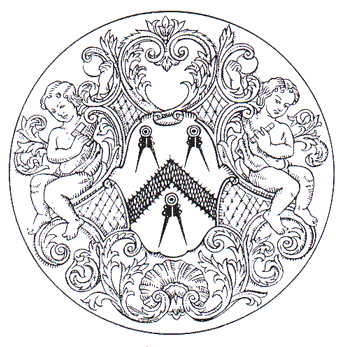
|
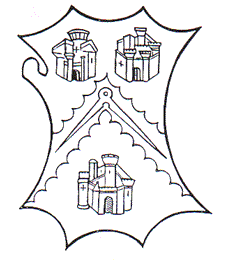
|
|
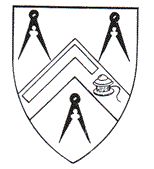
|
fig. 5 (top left) Carpenters' Company seal
fig. 6 (top right) Masons' Company seal
fig. 7 (left) A version of the Carpenters' Arms (Coll.
Arms Vincent, "Two Eaars of Wheat", c. 1530) |
Ridley gives another most telling example of the closeness of the trades when
he describes the preparations that had to be made for the encounter in France of
Henry VIII and Francis I. They met at what has ever since been known as 'The
Cloth of Gold', not least because of the ornate golden pavilion erected by
Humphrey Coke, the English King's Master Carpenter. This structure had a stone
base, l2ft high brick walls with wooden superstructure and canvas awnings. The
great chamber was 124 f'eet long, 42 feet wide and 30 feet high and was flanked
by a dining room, drawing room and chapel plus a cellar for 3000 bottles of
expensive wine. It can thus be seen that Coke commandeered the skills of not
only those who worked in stone and wood but of bricklayers and tent makers.
It is precisely that kind of interrelation that is reflected in the first
sets of Constitutions of the premier Grand Lodge of the Free and Accepted or
Speculative Masons of London and Westminster in 1722/23, compiled by the
celebrated Dr. James Anderson. He first states there:
Jabal found out Geometry and he divided Flocks of Sheep and Lands;
be first built a House of Stone and Timber… and there was a King called
Hiram who loved well King Solomon, and he gave him timber for the work.
Then, in case anyone might miss the inference that not only 'stone' workers
could be considered 'Masons' Anderson added this passage in the following year:
for then always, Masons, above all other Artists, were the Favourites of
the Eminent, and became necessary for their grand Undertakings in any sort
of Materials, not only in Stone, Brick, Timber,
Plaister; but even in Cloth or Skins, or whatever was used for Tents,
and for the various sorts of Architecture.
Nor should it be forgot, that Painters also, and Statuaries, were always
recon'd good Masons, much as Builders, Stonecutters, Bricklayers,
Carpenters, Joiners, Upholders or Tent-Makers,
and a vast many other Craftsman that could be nam'd, who perform according to
Geometry, and the Rules of Building; though none since HIRAM
ABIF has been renown'd for cunning in all parts of Masonry.
If then we can be assured that to the new kind of Speculative Masons
at least, the Carpenters were regarded as within the sphere of Geometric Masonry
it is hardly surprising that in the Masons' legendary history there should
appear the stories that were associated with the allied trades. In the
Constitutions of 1723 we read the following:
at length NOAH, the ninth from Seth, was commanded and directed of God to
build the great Ark, which though of wood, was certainly fabricated by
Geometry, and according to the Rules of Masonry.
"NOAH, and his three
Sons, JAPHET, SHEM AND HAM, all masons true, brought with them over the
Flood the Traditions and Arts of the Ante-deluvians (sic)…"
The story of how those 'traditions and arts' were so transmitted had
already been told in the 1722 edition of the Constitutions so this was merely
an amplification of that account.
That the story of Noah and his family's involvement with the Ark was
especially connected with the craft of the medieval Carpenters is
underlined by two facts. The first one has now been revealed afresh by
Jasper Ridsley's book — where he reproduces the four wall paintings of the 16th
century (c. 1545) which were later plastered over and only discovered in
Carpenters Hall: during its mid 19th century restoration. As can be seen (fig.
no. 8) the first of these paintings shows the Patriarch Noah in prayer before
the Almighty with his hat removed whilst his three sons are busily at work on
the vessel. (And note also the 'ladder' or flight of steps leading up to the
Lord in glory, which is surely reminiscent of a 1st Degree Tracing
Board feature.) This, on the walls of the Carpenters' official meeting place in
London, confirms the craft association and we shall see other connections
shortly.
|
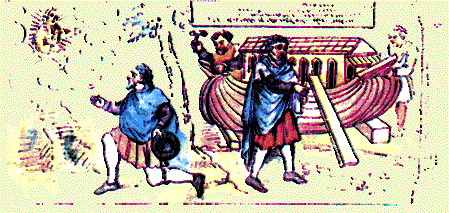
| fig. 8. Noah and the Building of the
Ark (now disintegrated). Tudor wall paintings: in 1845, workmen in the
Hall uncovered a wall painting. Artist Frederick William Fairholt
(1818-1866) made sketches and a full size fascimile of these murals. |
|
The second fact concerns the choice of plays in the Mystery cycles
held in many towns of England from the 14th to the late 16th century. What we
know here is that in Chester, Newcastle and York the Noah
play, or some part of it was claimed by the naval Carpenters or Shipwrights
because it involved the construction of an actual wooden hull, thus advertising
their trade skill. The Carpenters themselves in York and Chester undertook the
play of the Resurrection. In this play Christ rises up from a wooden
coffin in which he is supposed to have been laid in the tomb. The link between
this incident and the story well known to us as 30 Freemasons hardly
needs any comment especially when you consider some of our oldest extant 30
Tracing cloths (fig. nos. 9 & 10).
| fig. 9 & 10. Third Degree
Tracing Boards. |
Yet even this evidence is not all that we have to work on. There are at least
three more matters that merit our attention.
The next common factor between the two trades was the choice of a common
patron. This was the Virgin Mary, the mother of Jesus. For the Masons
the choice seemed self-evident. Jesus was the chief cornerstone of the Temple
and the keystone of its arch. Mary was symbolically known as the 'temple' from
which the glory of the Lord emerged and therefore, as the mother of Jesus it was
natural that she should be chosen by those who brought forth shapes
from stone. The fact that she was also referred to by medieval writers as 'a
tower', and that that symbol appeared on the Masons' coat of arms, further
cemented the link.
For the Carpenters no less the fact that Mary was both the wife of a
carpenter, Joseph, and the mother of Jesus who was thought to have served an
apprenticeship and been trained in this craft, made her choice as the Patron of
these woodworkers abundantly obvious. Indeed, another of the Tudor,
wall-paintings in Carpenters' Hall (fig. no. 11) shows Mary (without a halo),
Jesus as a child apprentice (but with a halo) learning which timber pieces to
select, and Joseph as a Master Carpenter with hat, wand, robe and gloves just
like a Master of the Stonemasons of the time. That the Master and Wardens of the
Carpenters Company had such hats is revealed by another of Jasper Ridley's
photographs showing the actual head gear worn from the Tudor period. (fig. no.
12).
|
fig. 11 Christ in Carpenter's Shop. fig.
12 Tudor hats, resemblance with Knight Templar hat. |
When it is further recognised that because of this common patronal dedication
the two crafts would share the same holy-days (or holidays, when apprentices
were freed from labour), and the same religious and legendary traditions, the
connection between the Masons and the Carpenters appears even stronger.
There is also something else. The guilds had secondary patrons who were
saints and their particular plays were presented in even earlier days than the
Corpus Christi performances. For the Masons these patrons were the two
Saints John whilst the Carpenters honoured St. Lawrence. Jasper
Ridley informs us that the election date of a Master of the Carpenters was
originally St. Lawrence's day and that was also the occasion for performing a
play associated with the Saint. It is not possible to enter here into a full
description of the story of this distinctive character but one of the intriguing
symbolic facts in his play was that before being put to death by being broiled
alive on a squared gridiron (the very shape of Philip. II's Escorial
Palace near Madrid which was also dedicated to this Saint) the gestures adopted
in the play are all based on squares. Thus when the Saint stood before
his accusers he had his arms akimbo, that is, the hands on the hips and the arms
at right angles from the body, and when he gave assent to any question he turned
his right hand over to the front and extended it at right angles to his body.
That is why Freemasons to this day give their assent in this fashion. This
ancient practice of a Carpenter saint has been 'retained' even in our current
speculative Masonic system.
It would seem therefore that at the very outset of the development of our
ritual and legend, following the establishment of the premier Grand Lodge in
London in 1717, there was a double source of material from which to draw. The
Brethren who devised the ceremonies: that were to become the pattern of 18th
century practice in England could avail themselves not simply of those
traditional echoes that connected the new 'Craft' with stonemasons but
with those of the timber-working carpenters as well. What more natural
then that in the formation of our l8th century Masonic practice there should be
two legend sources relating to the very fundamentals of the
Bible story.
The first of these was the story recounted by Anderson in his 1722
Constitutions, of the preservation and transmission of the Seven Liberal
Arts and Sciences of mankind by the creation and protection of two great pillars
that linked Adam, via Lamech, to Hermes and the period after the Flood. It will,
I think, be helpful if we remind ourselves of some of the story as it was first
recorded:
Lamech… had two wives, the one called Ada the other Zilla; by Ada he begat
two sons, Jabal, and Jubal; by Zilia he had one Son called Tubalcain, and a
Daughter called Naamah. These four children found the beginning of all
Crafts in the world… Tubalcain found out the Smith's Trade or
Craft, also of Gold, Silver, Copper, Iron and Steel. And these Children
did write these sciences, that they had found, on two Pillars of Stone,
that they might be found after that GOD had taken vengeance; the one was
Marble, that would not burn, the other was Latress, that would not drown in
Water…
It is noteworthy that there is an immediate difference about the substances
which formed the pillars though the introduction of the term, 'stone' obviously
attempted to claim them as of relevance to Stonemasons.
This legend was to pass through many variations but was eventually enshrined
in the Lecture attached to our usual Second Degree where we read:
These pillars were formed hollow, the better to serve as archives
for Masonry, and therein were, deposited the Constitutional rolls.
They were made of brass.
(NB: &mdash not now for Arts and Sciences, nor of stone.)
It is also noteworthy that we retain as the password from the 2nd
Degree the name 'Tubalcain' that creates a link with the older tradition and
emphasizes the place of the other crafts within Masonry.
The second legend was related to the former since it was based on the p1ace
of Noah and his descendants in the preservation of the 'true secrets' of the
Craft. Following on the passage quoted earlier about Noah in the 1723
Constitutions we read that Noah and his sons
amply communicated them (the Arts and Sciences) to their growing Offspring;
for about 101 Years after the Flood we find a vast number of 'em, if not the
whole Race of Noah, in the Vale of Shinar… afterwards known by the names of
CHALDEES and MAGI, who preserved the good Science, Geometry, as the
KINGS and great Men encouraged the Royal Art. But it is not
expedient to speak more plain of the Premises, except in a formed Lodge...
This underlined sentence indicates that what we have here is not simply a
form of historical record but part of what was already called 'ritual' or the
form of words employed in Lodge ceremonies.
It is precisely because we now find ourselves caught up in this core of
Masonic activity, the ritual that identifies and distinguishes
Freemasonry from other forms of social association and intercourse, that we need
to re-examine an acknowledged early ritual document that not only highlights the
story of Noah and -his sons but attaches to them practices having very
strong similarities to what has been, from the 18th century, a principal facet
of what we call ‘Free and Accepted Masonry’.
The document is called the Graham Manuscript and its date is ambiguously
recorded as 1 7 2 6, which might be 1726 or 1672. Whilst
it is likely that no firm conclusion can be reached as to which is the most
correct date it can at least be asserted that qualified and expert examination
of the writing in the original document has put on it a late 17th century
provenance and we certainly know that 1726 is the latest date by which
it could have been transcribed. Moreover Bro. Herbert Poole, who first drew the
attention of the Masonic world to the Graham Ms., gave it a his considered
opinion that the Noah story was known to the Craft "in its amplest form at
least 21 years before the formation of the (premier) Grand Lodge." That
would make it contemporary with the very period in which something like our
forms of Speculative Masonic practice were being assembled. What is of especial
interest is that this form of 'ritual story' was either discontinued, forgotten
or suppressed and only re-emerged, apparently by chance, some 50 years ago. Why
that should have happened in 1937 is an intriguing matter in itself but not
immediately relevant to our present study.
What is certainly relevant is the fact that we have here the story of Noah,
the keeper of the secrets of the 7 Liberal Arts and Sciences, declaring that the
disclosure of those secrets can only take place when three are present (a treble
voice) but dying before he has made those secrets known.. An attempt is made by
the three sons to raise their father, and with F.P.O.F., so that the
secrets in his grave might be discovered, but without success, and the search
for the desired goal is indicated as being by yet other means. The
closeness of this story to the subsequent 'ritual' of the 30 cannot
be ignored and since we have no other extant material to explain where the
'Hiram legend' of post-1726 came from it is worth investigating further the
possible link between the Graham Ms. text and its later counterpart.
If what I have said in the first part of this paper has any viability at all
then there would have been a perfectly natural place for a story based on the
Scriptures and regarding Noah, his sons, their 'secret inheritance', and a
manner revealing and transmitting that inheritance to be part of early Masonic
practice. It would not only be fitting - it would be more than likely. When,
moreover, we find that even as late as 1738 another form of the Grand Lodge
Constitutions has a direct reference to Masons as Noachidac or ,'Sons of Noah'
the recognition that a Noachic approach to the new form of Speculative Craft was
normal and acceptable has to be acknowledged. Though I shall refer later to what
more may be said about this term 'Noachidac' its persistence at this date
means that at least up to this time some association between 'Masons', using
this term in its widest sense, and the Noah story or legend, was perceived. The
Graham Ms. gives shape and reality to that association.
Whilst it would be excessive to quote at length from this Masonic source, and
the full text is available to all those needing it in Vol. 80 of the Ars Quatuor
Coronatorum (1967), it will be useful if we consider briefly the style of the
document and then make three comments on the main content which has a relevance
for the theme of this paper. I fully appreciate that this may at first seem to
be using the document to support a thesis already decided on, but I hope that by
looking at the actual text the comments that follow may help to dispel any
suggestion of this kind of post hoc reasoning.
What strikes one at once when confronted by the Graham Ms. is that this looks
like a document for use in a lodge rather than a literary production for
private perusal. It has obvious links with what are called the Old Charges and
following a commentary made in 1967 (AQC 80, p.100) Harry Carr wrote this:
It seems highly probable that the Graham collection of legends were indeed
an inherited tradition and not the invention of the man who transcribed
them... Collectively (i.e. with the Old Charges) they seem to represent a
separate store of Craftlore originally unconnected with its ritual
practices, but available for adoption into the ritual when necessity arose or
opportunity offered.
It is noteworthy that neither Harry Carr nor anyone else in 1967 can suggest
where that store of Craft lore came from. Yet that these legends now
seem to have begun to be used for ritual is confirmed by the Introduction to the
Ms, which seeks to ascertain that the person who is to benefit by its contents
is a bona fide Free & Accepted Mason. I quote:
The Sailutation is as follows
from whence came you — I came from a right worshipfull Lodge of Masters and
fellows… who doth greet all true and perfect brothers of our holy secrets
so do I you if I finde you to be one...
How shall I know you are a free Mason…
How were you made a free mason... etc."
These and the subsequent questions and answers, all in the form of an early
catechism, underline the antiquity of the shape and the content of this
manuscript but suggest that we are still very much at 'the outset of our English
18th century ritual journey. Let us, however, reflect on the main feature of the
rest of the manuscript.
The first observation has to be that what is most striking is that there are
shown to be three stages to full Masonic knowledge. These are connected
with Noah, Moses and Solomon. It is hardly a coincidence that all these stages
involve a close connection between workers in stone and timber. Noah,
we see, inherits the stone pillars of 'secret' knowledge that will, like his
wooden Ark, survive the Flood, whilst his offspring, the Babillonians (sic),
construct their mighty tower.
Bazalliell, the craftsman chosen by Moses, appears as the creator of another
wooden Ark that is to be the salvation symbol of the later desert-wandering
descendants of Noah and which is lodged within a 'tent' of wood and canvas with
the two great 'stone' pillars at the entrance.
Solomon then appears and erects his more permanent House for the Lord with
its stone walls and pillars but cedar panelled chambers and especially a gilded
sanctum for the same wooden Ark of the Covenant. The union of the two great
Crafts of carpentry and stone-building could not be more dramatically displayed.
The second observation has to be that these very stages are retained
in the traditional 'histories' recorded by Anderson and we are thus confirmed in
the view that Anderson was not fantasising when he said in 1738, “Masons were
first known as Noachidac”. He might just have been recording the death-knell of
old Carpenter legends as part of the mainstream progress of English Speculative
Masonry but he was at least signaling an era of legend evolution that forms part
of our heritage. That the Noachic aspect of our Masonic culture did so diminish
is remarkably parallel led by other artistic trends. I have just read this
passage in a novel of 1989 (Julian Barnes: History of the World in 10
1/2 Chapters, p.137f.):
For the first dozen or more Christian centuries the Ark (usually
represented as a mere box or sarcophagus to indicate that Noah's salvation was
a pre-(de)monstration of Christ's escape from his sepulchre) appears widely in
illuminated manuscripts; stained glass windows, cathedral sculpture. Noah was
a very popular fellow… But where are the great paintings, the famous images
that these are leading up to? The Ark eventually reaches the horizon, and
disappears over it. In Poussin's 'The Deluge' (early 18th
century) the ship is nowhere to be seen. Old Noah has sailed out of
art history.
The third observation therefore has to be a question. Why did Noah, his sons
and their offspring begin to do the same in Masonic legend and ritual? Let us
here consider what Bro. Harvey, the author of the AQC article of 1967, has to
say:
… in the early years of Grand Lodge, roughly 1722 to 1725, Desaguliers and
his friends thought it convenient to reshape what they considered arresting in
the ritual — apparently Graham's legends or something like them. For practical
reasons they kept the Pillars then fashioned the remaining salient features
into a dramatic fidelity legend. To gain coherence, all the action was brought
to Jerusalem, home of the Pillars degree. Hiram the widow's son and Bezaleel
merged easily into a single character. The main problem lay with the quest for
substituted secrets and in the transformation of dead Noah into living Hiram.
But this invention should not have given well-read men much trouble.
(p.85/86)
With all that I can agree but one question still persists Why did they do it
that way round and not make the central theme one based on Noah? Because they
were theologically and culturally well-read I think it was because they knew the
Noah tradition was not a stonemasons' tradition, because the Noah
tradition had a long-standing connection with a resurrection of Christ motif,
and because it also had strong links with Nimrod and the Tower of Babel, and the
'occult' associations of Ham. To shift the story to a less well-known, half-son
of Israel must have solved a lot of difficulties at one stroke. But it shows how
very valuable and helpful the Graham form of legend was.
Bro. Bathurst, however, has another telling comment:
What is very strange is that Noah, Bezaleel, and the Warden's Wicket, (all
features of the Graham story) having been consigned to oblivion did not
stay there. Men who can hardly have ever heard of Thomas Graham dug them
up again, years later, as the basis of additional ceremonies." (p.91, AQC 80)
That is where the degree of Royal Ark Mariner comes in and why its first
protagonists in the latter 18th century claimed for it an ancestry of a
century earlier that has hitherto been regarded as both excessive and even
ludicrous — a judgement that may now have to be reassessed. What is also
interesting is that in the earliest forms of the Ark degree it was not just
the story of Noah's Ark that was told but the erection and then dismantling of
the Tower of Babel. Anderson's reference to Masons as 'Noachidae' was not
simply harking back to an early tradition. As a 'basis of that natural
religion' on which all Masons can agree he is here suggesting that we are
those who accept the Noachite Laws as our standard. (See my Arch and The
Rainbow — p.353) Whilst to clinch the persisting influence of the Noah
tradition in our English Craft it was his dove that replaced the Sun and Moon
or figures of Hermes — Rosicrucian emblems — on the Deacons' wands after the
union of' 1813. The legend of the Carpenters is thus still woven into the
Stonemasons' working.
Only one more aspect of this thesis remains to be tackled. As the secrets
promised in the Graham Ms. still remained hidden despite being once disclosed by
Bezaleel to the two Princes of Alban — and about this name I believe much more
is soon going to be revealed — so there had to be a new way- of recovering and
revealing them to the complete Master. That required new forms of older legends.
Dr. Oliver showed that the Rainbow symbol formed part of an early Royal Arch
ceremony and as the Tower of Babel fell, and communication faltered between the
builders, so it was from Babel, or Babylon, that the restoration of the edifice
that contained the secrets had to come. Bezaleel with the Mosaic 'Ark' also had
to figure as did the rediscovery of the true "Word" of the Almighty from under
the Temple. It will surely not surprise you if I tell you that another picture
from Tudor times that adorned the Carpenters Hall shows King Josiah instructing
his people to rebuild the Temple in Jerusalem (fig. no. 13).
Why, we wonder, was the Josiah story part of the Royal Arch story in early York
Masonry as it is still the core of the Irish Royal Arch ceremony to this day?
May I suggest that just as the Carpenters', other legends and paintings
influenced the stories in our Craft degrees so too they had their effect on the
development of another ritual stage.
|
fig. 13. King Josiah gives instructions
for rebuilding of the Temple in Jerusalem. |
There is much more that could and should be said. What are we to deduce, e.g.
from the fact that all the figures in these biblical wall-paintings all wear
contemporary dress? But I must stop and rest my case. I submit that another
whole strand in the great tapestry of our origins has at last revealed itself.
back to top | ![]()






